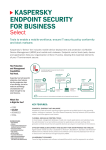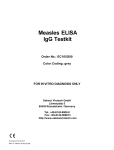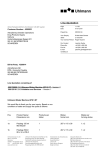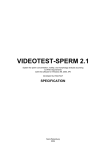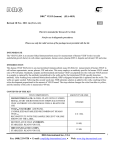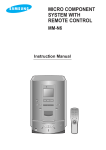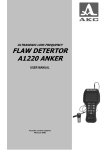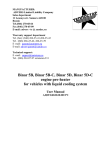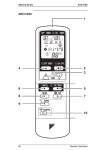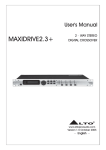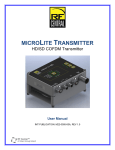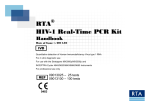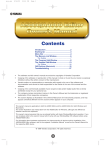Download Vitrotest Rubella-IgM ultra ELISA test-kit for qualitative determination
Transcript
Vitrotest Rubella-IgM ultra ELISA test-kit for qualitative determination of IgM class antibodies to rubella virus Instruction for use 1. Intended use 2. Clinical value 3. Principle of the test 4. Materials and equipment 5. Reservations and safety precautions 6. Storage and stability 7. Specimen collection 8. Reagent preparation 9. Assay procedure 10. Calculation and interpretation of the results 11. Performance characteristics 12. Limits of the test Reference souces Legend For in vitro diagnostic use ТК004 ELISA test for the diagnosis of infectious diseases TS (ТУ.У 24.4 – 36555928 – 001:2011) «Vitrotest Rubella-IgM ultra» ELISA test kit for qualitative determination of IgM class antibodies to rubella virus 1. Intended use ELISA test-kit «Vitrotest Rubells-IgM ultra» is intended for qualitative determination of IgM class antibodies to rubella virus in human serum or plasma. The test kit may be used both for the ELISA using automatic pipettes and standard equipment and for setting with the open-system immunoenzymatic automated analyzer. 2. Clinical value Rubella is a viral infectious disease characterized by skin rash, generalized lymphadenopathy, mild intoxication and short-lived fever. Usually the disease is rapid and mild. Particular importance of rubella infection is connected with the risk of serious complications for the child that may develop with infection of the mother during pregnancy. Given that the symptoms of the rubella disease are often few expressed, and in 30-50% of cases occur without noticeable symptoms, laboratory diagnostic methods are acquiring particular importance. After vaccination, as well as in primary infection with rubella virus, the first there are specific immunoglobulins IgM; after infection they are recorded in 3-5 days after the appearance of rash; and after vaccination antibodies of this class begin to appear in the blood at the third or fourth week. Specific IgG antibodies begin to be produced by the body on 7-10 th day since the clinical manifestations, reaching a maximum after 4-5 weeks and remained at a high level for a long time. Reliable evidence of acute rubella infection is the presence in serum of specific antibodies of class IgM, which are also considered evidence of congenital rubella in infants. IgG antibodies against rubella virus can be considered a sign of a previous rubella infection, because the presence of these antibodies in serum indicates the end of an active infection. Determining the level of specific IgG antibodies makes it possible to estimate the intensity of immunity after previous infection or vaccination and predict the possibility of disease in the case of re-infection. 3. Principle of the test Principle of the test of «Vitrotest Rubella-IgM ultra» kit is based on an indirect enzyme immunoassay technique. The solid phase is made of strip microplate coated with the purified antigen of rubella virus. During incubation of samples in wells of ELISA plate specific to rubella virus antibodies are bound to the antigen on the solid phase. After washing out unbound components anti-specific conjugate of anti-IgM monoclonal antibodies with horseradish peroxidase added to the wells, it binds to immune complexes in the solid phase. Unbound components are washed out. The immune complex formed in the wells are visualized by adding chromogen solution of 3,3',5,5'- tetramethylbenzidine (TMB). As a result of the reaction solution in wells where immune complexes were formed would be painted in blue. The reaction is stopped by adding stop reagent, blue colored wells become yellow. The result of the analysis is determined by spectrophotometric reading at 450/620 nm. 4. Materials and equipment 4.1 Contents of the kit ELISA plate – 12 strips of 8 wells (with the possibility of separation of the wells) with immobilized antigen of Toxoplasma gondii. Positive control – 1 vial containing 0,3 ml solution of specific immunoglobulis (pink). Negative control – 1 vial containing 0,5 ml negative human serum (yellow). Sample pre-diluent – 1 bottle containing 12 ml buffer with detergent and preservatives (brown-green). Sample diluent – 1 bottle containing 12 ml buffer with detergent and preservatives (yellow). Conjugate solution – 1 bottle containing 12 ml buffer solution of monoclonal antibodies to human IgM conjugated with horseradish peroxidase, with stabilizers and preservatives (violet). Ready to use. Washing solution Tw20 (20х) – 1 bottle containing 50 ml 20-fold concentrated phosphate buffer with Tween 20 (colourless). TMB Solution – 1 bottle containing 12 ml of TMB solution and hydrogen peroxide, with stabilizers and preservatives (colourless). Stop-reagent – 1 vial containing 12 ml of 0,5M sulphuric acid solution (colourless). Plate for pre-dilution of serum – 12 strips of 8 wells. Adhesive film – 2 sheets of adhesive film for covering the plates during incubation. Sera identification plan – 1 sheet of paper for noting the schemes of samples distribution. Instruction for use – one copy of user manual. 4.2 Additional reagents, materials and equipment In order to conduct the analysis, the following additional reagents, materials and equipment are required: – deionized or distilled water; – filter paper; – graduated cylinders of 10, 200 and 1000 ml capacity; – disposable gloves; – hydrogen peroxide solution 6%; – disposable glassware for preparing the reagents (bottles and trough); – timer; – mono- and multi-channel automatic adjustable pipettes capable of delivering volumes of 20, 200 and 1000 microliters and tips for them; – thermostat for 37 °С; – container for solid waste; – container for liquid waste; – 1automatic or semi-automatic washer; – 2mono- or multi-channel reader for microplates at 450/620-695 nm. 1,2 Please, consult us about the adaptation of your equipment. 5. Reservations and safety precautions nosology; 5.1. Reservations: – do not use expired reagents; – do not use in the analysis and do not mix components of different lots and components of test kits with different – do not use reagents of other manufacturers in composition with the Vitrotest® sets; - Note: possible to use washing solution Tw20 (20X), Sample pre-diluent, TMB solution and Stop-reagent with other series that are different from those attached to the test kit. These reagents are used in other test systems of Ramintek IPC. Please consult us for details. – close reagent vials after use only with their appropriate caps; – strictly follow to the washing procedure requirements described in this instruction; – control the filling and full aspiration of the solution in the wells; – use a new distribution tip for each serum and reagent; – protect kit reagents from straight sun rays; – TMB solution must be colourless or light blue before its use. If solution is dark blue or yellow, it cannot be used. Avoid any contact of the TMB solution with metals or metal’s ions. Use glassware thoroughly washed and rinsed with deionized water. – use only disposable pipette tips for adding TMB-substrate into plate’s wells; – never use the same glassware for conjugate solution and chromogen. 5.2. Safety precautions: – all reagents included in the kit are intended for “in vitro” diagnostic use; – wear disposable gloves when perform analysis; – do not pipette by mouth; – the controls of «Vitrotest Rubella-IgM ultra» are negative for anti-HCV, anti-HIV1/2, anti-T.pallidum antibodies and HBsAg. Nevertheless, all controls and sera should still be regarded and handled as potentially infectious; – the liquid waste must be inactivated, for example, with the hydrogen peroxide solution at the final concentration of 6% for 3 hours at room temperature, or with the sodium hypochlorite at the final concentration of 5% for 30 minutes, or with other disinfectant agents; – the solid waste must be inactivated with autoclaving at 121°С for 1 hour; – do not autoclave the solutions that contain sodium azide or sodium hypochlorite; – avoid spilling of TMB-solution and Stop-reagent and any contact of these solutions with the skin or mucosa; – in case of spilling of solutions, that do not contain acid, e.g. sera, rinse the surface with hydrogen 6% solution, then dry with filter paper. 6. Storage and stability Reagents of the kit are stable up to the expiry date on the label, when stored at 2-8 °С. Transport the test-kit at 2-8 ºС. Disposable transportation at temperature not higher than 20ºС during two days is allowed. 7. Specimen collection The serum or plasma samples should be stored at 2-8 ºС not more then 3 days after collection. It is possible to store them longer, but frozen (-20 to-70 ºС). Before use frozen samples, wait for 30 minutes for the reagents to stabilize at room temperature. Mix thawed samples well to homogeneity. Avoid repeated freezing/thawing. Samples containing aggregates must be clarified by centrifugation. Do not use samples with contaminated, hyperlipeamic and hyperhaemolysed sera. 8. Reagent preparation It is very important to bring all reagents of the «Vitrotest Rubella-IgM ultra» kit to room temperature (18-25°С) for 30 minutes before use. 8.1. ELISA plate preparation Before opening the ELISA plate, allow it to stabilize at room temperature for 30 minutes to avoid water condensation inside the wells. Open the vacuum bag and remove necessary amount of wells. Immediately after removal of wells, the remaining strips should be resealed with zip-lock and stored at 2-8 °С. Microplate in thus packed bag is stable for 3 month. 8.2. Washing solution The vial contains 50 ml of a concentrated 20X buffer with detergent. Dilute the washing solution 1:20 (1+19) with distilled or deionised water, then mix. For example: for 4 ml of concentrate – 76 ml of distilled water is enough for one strip. Crystals in the solution disappear by warming up to 37°С for 15-20 min. The diluted washing solution can be stored at 2-8°С not more than 7 days. 8.3. Pre-dilution of samples and controls Pre-dilute samples and controls by 10 times with sample pre-diluent. For this purpose, in the required number of wells of plate for pre-dilution of sera (comes in a set) dispense 90 µl of sample pre-diluent and add 10 µl of sera and controls. Gently pipette the mix in wells, avoiding foaming. After addition of serum color of the solution in wells changes from brown-green to blue. The procedure of dilution of samples and controls should be carried out immediately prior to analysis. 9. Assay procedure 9.1. Take out from the protective packing the support frame and the necessary number of wells (the number of investigated samples and five wells for calibrators). Wells with calibrators must be included in each analysis. 9.2. Complete the sera identification plan. 9.3. Prepare washing solution (refer to point 8.2). 9.4. Conduct pre-dilution of sera (refer to point 8.3). 9.5. Dispense 90 µl of sample diluent in each well. 9.6 Dispense 10 µl of pre-diluted controls and unknown samples into the wells in the following order: A1 – pre-diluted 1:10 positive control, B1, C1 and D1 – pre-diluted 1:10 negative control, E1 and rest wells – pre-diluted 1:10 unknown samples. Thus, the final dilution of serum in wells of ELISA plate should be 1: 100. Gently pipette the mix in wells, avoiding foaming – color of the solution in wells changes from yellow to green. 9.7. Cover strips with an adhesive film and incubate for 30 min at 37 °С. 9.8. After completing the incubation remove the adhesive film carefully and wash the wells five times using the automatic washer or 8-channel pipette in the following order: – aspirate the content of wells strips into a liquid waste container; – fill the strip wells with a minimum of 300 microliters of washing solution for each well (respect the soak time of a minimum of 30 seconds); – aspirate the solution of all wells, the residual volume of solution after aspiration must be lower than 5 microliters; – repeat the washing step four more times; – after the last aspiration blot the microplate by turning it upside down on absorbent paper. 9.9. Dispense 100 μl of conjugate solution per well. Cover strips with an adhesive film, incubate for 30 min at 37°С. 9.10. After completing the incubation remove the adhesive film carefully and wash the wells five times as described above (refer to point 9.8). 9.11. TMB-solution is ready to use TMB-substrate solution with hydrogen peroxide. TMB-solution should be colorless, protect TMB-substrate solution from straight sun rays. To add TMB-solution only new tips must be used: carefully select a TMBsolution from the vial and without touching the bottom and walls of the hole plate, add 100 μl TMB solution per well. 9.12. Incubate the strips for 30 minutes at room temperature of 18-25°С in the dark. Do not use adhesive film in this incubation. 9.13. Add 100 μl of stop-reagent in each well. Respect the same distribution sequence than for the TMB-substrate solution. 9.14. Read the optical density of every strip well in dual wavelength reading at 450/620 nm, within the 5 minutes of stopping the reaction. Pay attention to the cleanness of the wells bottom outside. Measurement in the single-wave procedure at 450 nm is possible. Reserve blank well to adjust spectrophotometer in such analysis. Only TMB-substrate and stop-reagent must be added in blank well. 10. Calculation and interpretation of the results 10.1. Test validity conditions: Calculate the mean optical density (OD) of negative control OD NCmean = (ОD NC1+ ОD NC2 +ОD NC3)/3. In order for an assay to be considered valid, the following criteria must be met: – OD of the positive control is not lower than 1,2 optical unit (OU), – OD of negative controls should be lower or equal to 0,15 OU; – OD of every negative control differs no more than twice from the mean value of negative control, that is OD NCmean × 0,5 ≤ OD NCn ≤ OD NCmean × 2,0. If one of the negative controls does not respect this norm, disregard and recalculate the mean using remaining values. 10.2. Calculation of the results. Calculate cut-off by adding value 0,3 to the mean NC, that is Cut off = OD NCmean + 0,3 Calculate the index of positivity (IP) for each sample IP ODsample Cut off 10.3. Interpretation of the results The samples with IP above 1,1 are considered positive (IP > 1,1). The samples with IP below 0,9 are considered negative (IP < 0,9). The samples with IP within 0,9-1,1 are considered indeterminate (0,9 ≤ IP ≤ 1,1). It is recommended to retest such samples in duplicate. If the results are again within indeterminate, it is necessary to test sera obtained after 2-4 weeks. If you get undefined results assume that the serum is negative. 11. Performance characteristics 11.1. Specificity and sensitivity Specificity and sensitivity of the test «Vitrotest Rubella-IgM ultra» were evaluated using commercial panel «AntiRubella Mixed Titer Performance Panel PTR201» production "SeraCare Life Sciences" (USA) which consists of 5 samples containing IgM antibodies to rubella virus and 20 sera not containing specific IgM antibodies. In the test «Vitrotest Rubella-IgM ultra» all samples of panel PTR 201 were determined correctly according to passport data. In the study of specificity of the test «Vitrotest Rubella-IgM ultra» using 154 sera negative for antibodies to rubella virus all 154 sera were found negative. In comparative studies of the test «Vitrotest Rubella-IgM ultra» and another commercial test with CE marking were analyzed 12 sera containing IgM antibodies to rubella virus (including four sera obtained from vaccinated persons at 24-28 days after vaccination) all of these samples were found positive in both test -system. 11.2. Accuracy Intra assay reproducibility Coefficient of variation (CV) was calculated in 32 repetitions of two sera with different level of specific antibodies on two series of test kits. Serum № OD mean CV1, % CV2, % S10 0,898 7,4 5,9 S7 1,732 6,5 5,8 Inter assay reproducibility Coefficient of variation (CV) for two sera with different level of specific antibodies was calculated for three days in three ELISA performance, in eight repetitions for each analysis. Serum № S10 S7 OD mean 0,931 1,820 CV, % 7,1 5,2 12. Limits of the test A positive result in the test «Vitrotest Rubella-IgM ultra» is an evidence of presence in patient of antibodies of class IgM, specific to rubella virus. IgM class antibodies present in the blood during acute rubella infection in children and adults, regardless of severity of clinical manifestations, and in infants with congenital rubella infection. For diagnosis should take into account both results of laboratory tests and clinical manifestations of the disease. For the purpose of leveling of false-positive results caused by the presence in samples of human blood serum autoantibodies specific for immunoglobulins G (rheumatoid factor), in the test is used a special block-component that prevents the formation of immune complexes with anti-human antibodies on the solid phase. Reference sources 1. Center for Disease Control and Prevention. Rubella and Congenital rubella syndrome: United States, 1994-1997. – MMWR, 1997. – V. 46. – P. 350-354. 2. Knox E.G. Theoretical aspects of rubella vaccination // Rev. Infect. Dis. – 1985 – V.7. – P. 194-197. 3. Tischer A., Gerike E. Immune response after primary ad revaccination with different combined vaccines against measles, mumps, rubella // Vaccine. – 2000. – V.18 – P. 1382-1392. 4. WHO. Guidelines for surveillance of CRS and Rubella // WHO, 1999. – 92 p. 5. Zimmerman L. Chapter 11: Rubella // VPD Surveillance Manual, 3rd edition. – 2002 – P. 11.1-11.12. Legend Interpretation of notation conventions: For in vitro diagnostic use Batch code Catalogue number Production date Expiry date Storage temperature limitation Meant for <n> tests Protect from direct solar radiation Attention! Consult instruction for use Manufacturer and its address Consult instructions for use For questions and suggestions regarding the kit, contact the manufacturer: Ramintek Innovation-Production Company 03039 Ukraine, Kiev, 7 October 40th Anniversary Av., of. 227 (registered address) 07300 Vishgorod, Kiev region, 19 Sholudenko Str. (factual address) Tel. +380 44 222-76-72 Scheme of the assay «Vitrotest Rubella-IgM ultra» Keep reagents at room temperature 18-25°С during 30 minutes Prepare washing solution, dilute 20х concentrate washing solution Tw20 with distilled water 1:20 (1+19). For example, 4 ml of solution + 76 ml of water Complete the sera identification plan Prepare pre-dilution (1:10) of sera: in wells of plates for pre-dilution add 90 µl of sample pre-diluent (brown-green) and 10 µl of samples or controls. After dispensing of serum the color in well switches from brown-green to blue Dispense 90 µl of sample diluent (yellow) and add 10 µl of pre-diluted controls and patient samples into the wells : А1 – positive control, В1, C1, D1 – negative control, E1 and other wells – patient samples Cover wells with an adhesive film, incubate for 30 min at 37°С Wash wells five times Dispense 100 µl of conjugate solution (violet) into the wells Cover wells with adhesive film, incubate for 30 min at 37°С Wash wells five times Dispense 100 µl of TMB substrate solution into the wells Incubate the plate for 30 min in the dark at room temperature (18-25°С) Add 100 µl of stop-reagent in each well Read optical density at 450/620 nm Calculate the cut-off of the assay «Vitrotest Rubella-IgМ ultra»: Cut-off = OD NC mean + 0,3 Calculate the index of positivity (IP) for patient samples: IP OD of patient sample cut off Interpret the results according to the table IP value ІPsample > 1,1 0,9≤ IPsample ≤ 1,1 ІPsample < 0,9 Result positive indeterminate negative








